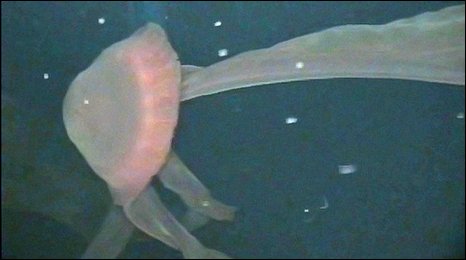
Using a remotely operated vehicle (ROV), they captured a video of the huge Stygiomedusa gigantea.
The jellyfish has a disc-shaped bell than can be a metre wide, and has four arms that extend up to six metres in length.
The jellyfish has only been seen 114 times in the 110 years it has been known to science, say researchers.
Professor Mark Benfield from Louisiana State University in Baton Rouge, US, came across the creature as part of the Serpent project, a collaboration between marine scientists and energy companies, including BP, Shell, Chevron and Petrobras, working in the Gulf of Mexico.
Using ROVs provided by the oil and gas companies, scientists are able to explore the deep ocean in more detail, including the so-called mesopelagic and bathypelagic layers of the sea.
In a similar study, researchers recently captured footage of one of the ocean's largest fish, the serpent-like oarfish.
Bizarre jelly
Not much is known about the jellyfish, but it is thought to be one of the largest invertebrate predators in the deep sea ecosystem.
Direct observations of these creatures from submersibles are very rare.
It has been previously videoed by scientists off the Pacific coast of the US and by ROVs off Japan.
However, this is the first time the giant jelly has been recorded in the Gulf of Mexico.
The researchers reported four chance encounters with jellyfish between 2005 and 2009, during the routine underwater work the energy companies carried out on their underwater structures.
The footage shows the reddish purple coloured jellyfish at depths ranging from 996m to 1747m.
Trap prey
The scientists observed the jellyfish attaching itself to the subsea equipment using its large flattened arms.
These "paddle-like" arms lack stinging tentacles, and scientists are unsure of their exact function.
It has been suggested that they might be used to envelop and trap prey. This may explain why the jellyfish appeared to grasp at the artificial structures.
One of the films the researchers captured also shows a fish swimming inside and in close proximity to the bell of the jellyfish.
This fish was believed to be Thalassobathia pelagica, a rare fish that has a symbiotic relationship with the jellyfish.
By swimming within the jellyfish it is able to feed on scraps of food and have a certain level of protection.
Prior to these observations neither Stygiomedusa gigantea or Thalassobathia pelagica had been found in the Gulf of Mexico.
By looking at previous studies and records of the jellyfish, the scientists were able to confirm the species is widespread, with records of it from all oceans except the Arctic.
This study represents the first attempt at a global synthesis of its distribution.
Professor Benfield and team hope that over time and with more encounters, all will be revealed about this giant and the creatures with which it shares the deep sea.
The study will be published in the Journal of the Marine Biological Association of the United Kingdom.



Reader Comments
to our Newsletter